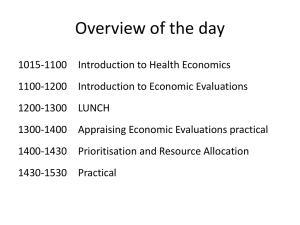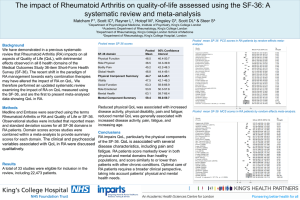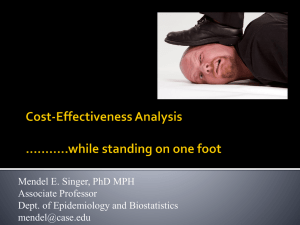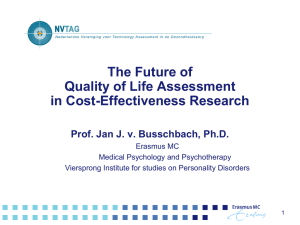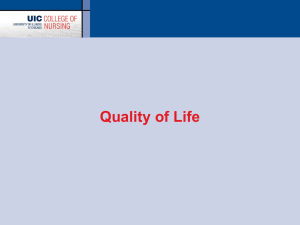Assessing Health and Economic Outcomes
advertisement
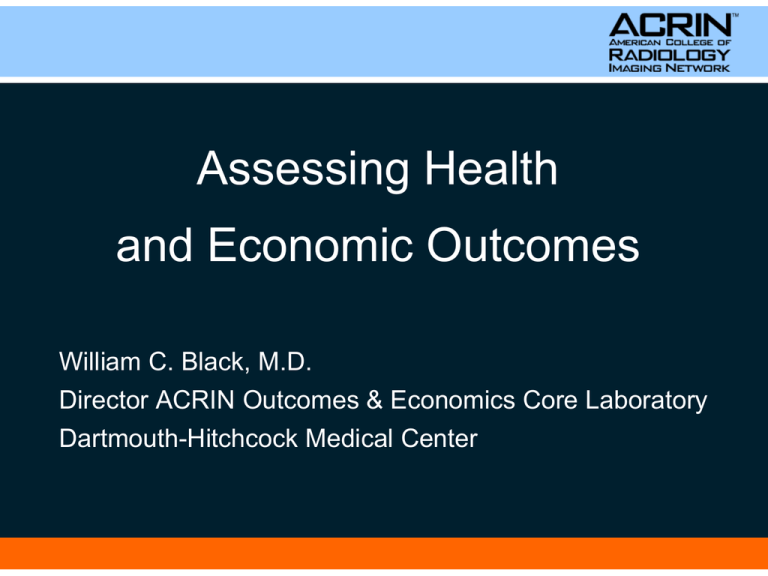
Assessing Health and Economic Outcomes William C. Black, M.D. Director ACRIN Outcomes & Economics Core Laboratory Dartmouth-Hitchcock Medical Center Outline • Background • Health outcomes • Economic outcomes • Cost-Effectiveness Analysis “Outcomes” • Geography is destiny • More is not better • Patient preferences matter US Health Care Expenditures $2.50 Trillions $2.00 $1.50 $1.00 $0.50 $0.00 1960 1970 1980 1990 2000 2010 Year http://www.cms.hhs.gov/NationalHealthExpendData/02_NationalHealthAccountsHistorical.asp#TopOfPage Health Expenditures by Country, 2006 Life Expectancy by Country Country Life Exp Rank Macau 84.4 1 Japan 82.1 3 Canada 81.2 7 United Kingdom 79.0 36 United States 78.1 49 Mexico 76.1 71 China 73.5 108 Iraq 70.0 145 Growth in physician services “Outcomes” • Determine what works • Assess pt preferences • Deliver appropriate care Hierarchical Model of Efficacy • • • • • • Level 1. Technical Level 2. Diagnostic accuracy Level 3. Diagnostic thinking Level 4. Therapeutic Level 5. Patient outcome Level 6. Societal Fryback & Thornbury. Medical Decision Making 1991;11:88-94. Accuracy • SE = Pr(T+| D+) • SP = Pr(T-| D-) • Az = Area under ROC curve Disease Treat LED+B P No disease LEN-C 1-P Test positive Disease P CHOOSE Test SE Test negative 1-SE Test positive No disease 1-P 1-SP Test negative SP LED+B LED LEN-C LEN Disease No Treat P No disease 1-P LED LEN Baseline Values P 0.5 B, C 1.0 LEN 2.0 LED 0.0 SE, SP 0.8 Expected Utility Treat Test No Treat 1.0 1.3 1.0 Limitations • Disease spectrum • Accuracy of test • Natural History of dz • Effectiveness of treatment Randomized Clinical Trial To ensure that observed differences in outcome depend only on the interventions under investigation and not on other factors that affect outcome. Outcomes & Economic Core Lab • Measure Health Related QOL • Measure costs • Analyze cost-effectiveness Health Related QOL • Global rating • Symptoms • Functional status Health Related QOL • Non-preference based – Generic, e.g., EVGFP, SF-36 – Disease-specific, SAQ • Preference based – Direct, e.g., VAS – Indirect, e.g., SF-6D Measuring Preferences - Direct • Rating scale • Standard gamble • Time-tradeoff Visual Analogue Scale Standard Gamble Measuring Preferences - Indirect • Quality of Well Being • Health utilities index • EuroQoL-5D • Short Form -6D SF-6D 1. 2. 3. 4. 5. 6. Physical functioning Role limitations Social functioning Pain Mental health Vitality SF-6D Utility Scoring Physical Functioning Term Score PF1 -0.000 PF2 -0.053 PF3 -0.011 PF4 -0.040 PF5 -0.054 PF6 -0.111 U = 1.000 + ∑Score – 0.070 Brazier et al. J Health Econ 2002;21:271-92. Quality Adjusted Life Year • Measure of patient utility • Measured on a scale of 0-1.0 • Can be assessed directly or derived from health survey, e.g., SF-36 Quality Adjusted Life Years Quality of Life 1.0 QALY = 0.5+0.25 = 0.75 0.5 0 0.5 Quantity of Life 1.0 Economic Outcomes • Direct – inpatient care – outpatient care – medications • Indirect – time and travel Hospitalization Costs • Triggered by patient questionnaire • ICD-9, DRGs, and CPTs coded by MRA • Medicare reimbursement – Part A MEDPAR – Part B Physician Fee Schedule Outpatient Costs • Triggered by patient questionnaire • ICD-9 and CPTs coded by MRA • Medicare Physician Fee Schedule • Red Book avg wholesale prices Indirect Costs • Triggered by patient questionnaire • Travel and other expenses • Time from usual activities CEA • Societal perspective • In-trial and lifetime horizons • Discounting @ 3% • Sensitivity analysis Incremental Cost Effectiveness Ratio ICER = ∆COSTS ∆QALYS c cost II K IB IA effect IIIA IIIB IV Black. Med Decis Making 1990. 10(3): 212-4. Comparison STRATEGY Do Nothing Do Something COST QALYS CER 0 0 NA $100,000 4 $25,000 Chart Abstraction Process Summary • • • • • Variation in practice Rising costs unsustainable Radiologic imaging target “Outcomes” data collection essential Role of cost-effectiveness analysis
